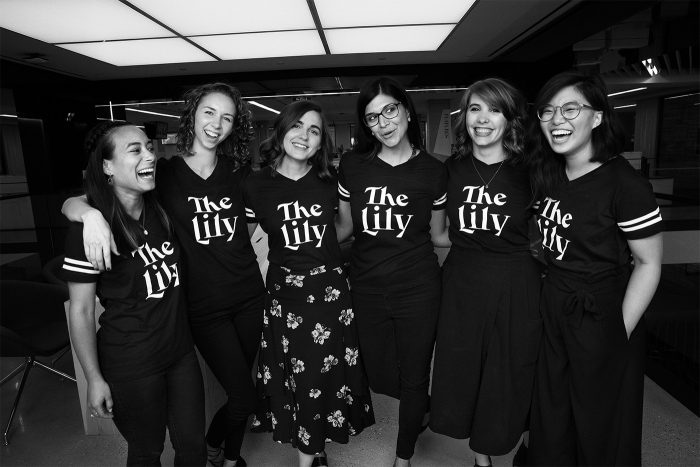It’s not that The Washington Post itself doesn’t post plenty of content that is appropriate for millennial women to read. But The Lily, a “publication for women” that the Post launched last week, starts with the premise that a lot of young women simply aren’t reading the Post at all and would respond better to news that comes on the platforms they’re already on — Facebook, Instagram, Medium, and Twitter, as well as a twice-weekly email newsletter, Lily Lines.
The Lily, which has six full-time people devoted to it (a seventh is yet to be hired), in some cases starts with articles that have already appeared in the Post and repackages them in a condensed form (that’s been the subject of some criticism). In other cases, the coverage is original to The Lily. It’s all packaged with a big focus on aesthetics; the graphics, across all the platforms, are black and white (no pink, thank goodness) with small pops of color. I spoke with Amy King, The Lily’s editor-in-chief and creative director, about why the Post decided to launch a pop-up publication and how it’s thinking about drawing readers to the paid (grownup) product. Our conversation, edited and condensed slightly, is below.
Laura Hazard Owen: When you were thinking about launching The Lily, what was the gap that you thought needed to be filled? How did you look at the space of sites aimed at millennial women and think about what was missing?
Amy King: One of the reasons we wanted to do this at The Washington Post is that we wanted to reach an audience we’re not reaching as well as we could. We thought it would be a successful strategy for us to take all of these stories that we think would be of interest to women, put them together in one place, and then put them out in places where women are already reading the news.
As far as the gap that we’d be filling, we really think that our project will stand out both in its quality and in our editorial voice.
Owen: How did you decide that a distributed content strategy made the most sense for this project?
King: We’ve been experimenting with distributed content throughout the Post in different ways. We just launched our Discover channel on Snapchat. But for this particular project, we wanted to go all-in on distributed platforms because it’s where millennial women are getting most of their news. We decided it made sense to find people where they already are and make it really easy for people to find the content that we think that they would enjoy.
Owen: Are you adapting existing Post content for The Lily or is it original?
King: We’ll have a mix of both. Our goal with The Lily is to surface stories about topics and issues that impact women’s lives, drawing from the robust reporting done by the Post newsroom as well as spotlighting diverse voices and perspectives from outside the newsroom.
Our main strategy is to make sure that we’re taking all of the content and making it work well on whatever platform we’re putting it on. On Medium, you’ll still see words because words work really well on Medium. But we’re also crafting the stories so that they look really good on a mobile phone, since that’s where most of our content will be viewed. On Instagram, the focus will be on images. It’s just tailoring each piece of content to the platform that it’s going on.
Since we’ve launched, we’ve seen our original pieces resonate with readers: “Why America cares more about race than sexual assault,” “Why sex ed still falls on women more than men,” and Margaret Sullivan’s career advice piece.
Owen: How are you thinking about driving subscriptions to The Washington Post with this?
King: That’s not the main goal right now, but we are hoping that we’ll expose people to the Post who otherwise would not have been exposed to our content. [On The Lily], you’ll still be able to tell where a lot of the content is coming from. Our thinking is that many of these people would not have seen Post content at all, and now they’ll be starting to see, oh, the stories coming from this publication that might be of interest to me.
Owen: How do you plan to get readers involved? Do you see a role for them beyond just consuming the content?
King: We’re excited about what might happen with the Medium community, with the responses and highlighting. We’re hoping to be able to foster debates and discussions around topics relevant to women on that platform. In our newsletters, we have call-outs to readers. One of the stories we published on Medium today is based on a call-out that we did on Facebook asking women about their
experiences with their first period. It’s aggregated from a list of comments we got there. There’s a lot of experimenting to do with engaging readers and asking them to contribute content. We want to see what’s successful and what’s not, because there are a lot of ways to engage on all of these platforms.
Owen: Are there any specific lessons that the Post has learned from other experiments that will be applied to The Lily? What kind of back-and-forth will there be?
King: We’re hoping to learn lessons from this for the Post at large. I work on a team called emerging news products, and we’ve always been really focused on editorial design on digital platforms. If you’ve seen our
app with the blue icon, there’s a really big focus on design there, and we think that the curation of content and the attention to the design creates a better reading experience overall. The curation and design are lessons we’ve taken from other experiments that we’re applying to the Lily.
